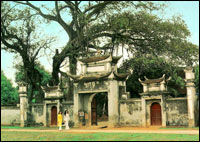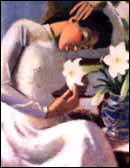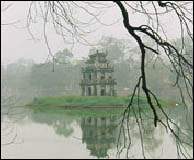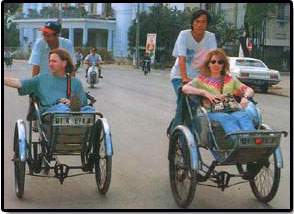Conference Venue and Transport
Le Quy Don Technical University (LQDTU)
Address: 100 Hoang Quoc Viet St, Cau Giay Dist., Hanoi, Vietnam.
About Hanoi
History
 Hanoi is a sacred land of Vietnam. In the 3rd century BC, Co Loa (actually belonging to Dong Anh District) was chosen as the capital of the Au Lac Nation of Thuc An Duong Vuong (the King Thuc). Hanoi later became the core of the resistance movements against the Northern invasions. Located in the middle of the Red River Delta, the town has gradually expanded to become a very rich residential center. At different periods, Hanoi was selected as the chief city of Vietnam under the Northern domination. In the autumn of Canh Tuat lunar years (1010), Ly Thai To, the founder of the Ly Dynasty, decided to transfer the capital from Hoa Lu to Dai La, and so he rebaptized it Thang Long (Soaring Dragon). The year 1010 then became an historical date for Hanoi and for the whole country in general. For about a thousand years, the capital was called Thang Long, then changed to Dong Do, Dong Kinh, and finally to Hanoi, in 1831. This sacred piece of land thereafter continued to be the theatre of many fateful events.
Hanoi is a sacred land of Vietnam. In the 3rd century BC, Co Loa (actually belonging to Dong Anh District) was chosen as the capital of the Au Lac Nation of Thuc An Duong Vuong (the King Thuc). Hanoi later became the core of the resistance movements against the Northern invasions. Located in the middle of the Red River Delta, the town has gradually expanded to become a very rich residential center. At different periods, Hanoi was selected as the chief city of Vietnam under the Northern domination. In the autumn of Canh Tuat lunar years (1010), Ly Thai To, the founder of the Ly Dynasty, decided to transfer the capital from Hoa Lu to Dai La, and so he rebaptized it Thang Long (Soaring Dragon). The year 1010 then became an historical date for Hanoi and for the whole country in general. For about a thousand years, the capital was called Thang Long, then changed to Dong Do, Dong Kinh, and finally to Hanoi, in 1831. This sacred piece of land thereafter continued to be the theatre of many fateful events.
Hanoian Beauty
 Vietnamese people in general and The Hanoian in particular are proud of the beauty of the Ao dai when they wear them in the special ceremornies such as: Tet holidays, Wedding Anniversary, Opening School Days, National & International Conferences etc...The Ao dai was considered as a symbol of traditional beauty from a time immemorial, up to now Hanoians have preserved, enhanced and created more and more beautiful Ao dai.
Vietnamese people in general and The Hanoian in particular are proud of the beauty of the Ao dai when they wear them in the special ceremornies such as: Tet holidays, Wedding Anniversary, Opening School Days, National & International Conferences etc...The Ao dai was considered as a symbol of traditional beauty from a time immemorial, up to now Hanoians have preserved, enhanced and created more and more beautiful Ao dai.
The pre-original Ao dai type was the 4-flap dress which was only worn on the occasion of the Tet festival. The brown dress with the two fore-flaps tied together and let dangling matches with satin trousers and silk belts. Then, the 4 flap dress has been modified into the 3-flap one: the collar being 2 cm high, the sleeves wrapping tightly to the wrists, breast and waist of main flaps, there is also a minor flap reaching down to the fringe. Buttons are made of plaited cloth and buttoned on the side. The collar is turned up obliquely to appear 3 colors (or 7 colors) of the dress. The outermost layer is of brown silk or a kind of black gauze, followed by light yellow, pink, lemon green, and sky-blue etc...
Nowadays, Ao Dai is a two-piece garment made of fabric, full-length dress worn over loose silk trousers reaching all the way to the ground. The dress splits into a front and back panel from the waist down. The dress length seems to be gradually shortening and today is usually just below the knee. Variations in the neck, between boat and mandarin style, are common and even adventurous alterations such as a low scooped neckline puffed sleeves or off the shoulder designs are appearing as ladies experiment with fashion. Women wear Ao Dai of various colors, often with intricate patterns and designs, in formal or work settings. Schoolgirls wear pure white, fully lined outfits symbolizing their purity. The Ao dai's grace, beauty and elegance significantly contributes to creating the own beauty for the Hanoian.
Geography
 Hanoi is located in the Red River Delta, in the center of the north of Vietnam. It is encompassed by Thai Nguyen Province to the north, Vinh Phuc and Ha Tay to the west and the south, Bac Giang, Bac Ninh and Hung Yen provinces to the east and the south-east. Hanoi means “the hinterland between the rivers?(Ha: river, Noi: interior). Hanoi’s territory is washed by the Red River (the portion of the Red River embracing Hanoi is approximately 40km long) and its tributaries, but there are some other rivers flowing through the capital, including Duong, Cau, Ca Lo, Day, Nhue, Tich, To Lich and Kim Nguu.
Hanoi is located in the Red River Delta, in the center of the north of Vietnam. It is encompassed by Thai Nguyen Province to the north, Vinh Phuc and Ha Tay to the west and the south, Bac Giang, Bac Ninh and Hung Yen provinces to the east and the south-east. Hanoi means “the hinterland between the rivers?(Ha: river, Noi: interior). Hanoi’s territory is washed by the Red River (the portion of the Red River embracing Hanoi is approximately 40km long) and its tributaries, but there are some other rivers flowing through the capital, including Duong, Cau, Ca Lo, Day, Nhue, Tich, To Lich and Kim Nguu.
Climate: Hanoi is situated in a tropical monsoon zone with two main seasons. During the dry season, which lasts from October to April, it is cold and there is very little rainfall, except from January to March, when the weather is still cold but there is some light rain. The wet season, from May to September, is hot with heavy rains and storms. The average annual temperature is 23.2oC (73.7oF) and the average annual rainfall is 1,800mm. The average temperature in winter is 17.2oC (62.9oF), but can go down to 8oC (46.4oF). The average temperature in summer is 29.2oC (84.6oF, but can reach up to 39oC (102.2oF).
Transportation
 There are plenty of taxis and mini-buses plying their trade between the airport and city center, and it is possible to hire either for a trip around town. Buses are cheaper, but with 13 different lines and numerous schedules that are difficult to find, it's certainly a challenge. The price can't be beat, however.
There are plenty of taxis and mini-buses plying their trade between the airport and city center, and it is possible to hire either for a trip around town. Buses are cheaper, but with 13 different lines and numerous schedules that are difficult to find, it's certainly a challenge. The price can't be beat, however.
The cyclo (xich lo), or pedicab, is a sort of rickshaw with a view. Negotiating a fare beforehand, then sitting back and relaxing as you witness the chaotic streets of Hanoi from your own mobile throne. Bicycles are another good way to navigate Vietnam's capital. You can rent anything from leaden Chinese road warriors to high-tech Japanese mountain-bikes, perfect for navigating those pot-holes and farm animals. Hanoi is strictly BYOH: Bring Your Own Helmet.
Renting a car or motorbike is a popular option, despite the presence of water-buffalo, chickens, maniacal truck drivers, bicycles laden with three or four struggling pigs, packs of hormone-crazed teenage boys in vehicles of every shape, size and color, all sharing the narrow, pockmarked roads and obeying traffic laws that have no parallel in the known universe. Consider riding with a local guide for a day or two before going it on your own.


